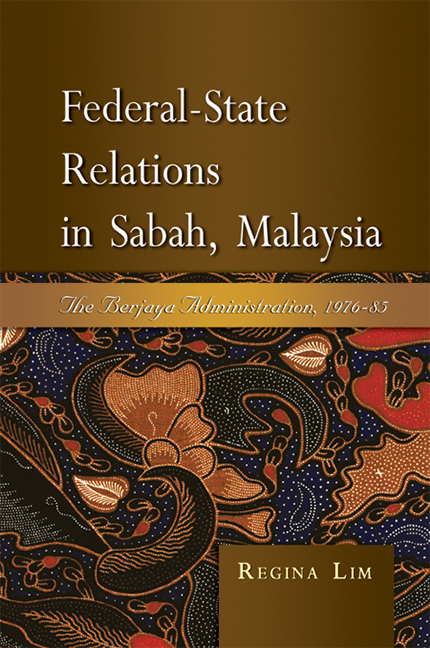Book contents
- Frontmatter
- Contents
- List of Tables and Figures
- Acknowledgements
- Abbreviations and Glossary of Terms
- 1 Introduction
- 2 Sabah Before Malaysia
- 3 Contesting the Rules of the Game, 1963–76
- 4 BERJAYA and Federal-state Relations
- 5 Development and Patronage
- 6 The Contest for Islamic Leadership and Multiracial Votes
- 7 Epilogue and Conclusion
- References
- Index
- About the Author
7 - Epilogue and Conclusion
Published online by Cambridge University Press: 21 October 2015
- Frontmatter
- Contents
- List of Tables and Figures
- Acknowledgements
- Abbreviations and Glossary of Terms
- 1 Introduction
- 2 Sabah Before Malaysia
- 3 Contesting the Rules of the Game, 1963–76
- 4 BERJAYA and Federal-state Relations
- 5 Development and Patronage
- 6 The Contest for Islamic Leadership and Multiracial Votes
- 7 Epilogue and Conclusion
- References
- Index
- About the Author
Summary
This book has examined the political dynamics of the relationship between ethnic politics and developmentalism in the context of a minority-dominated state on the periphery of a political federation. It has focused attention on a specific period associated with the emergence, rise, and demise of the BERJAYA party in Sabah. It has argued that the BERJAYA period was instrumental in the reshaping of Federal-State relations in Sabah, and that the contours of BERJAYA's political fortunes can best be understood by locating it within the competing pressures of ‘bottom-up’ demands for political and cultural autonomy and the ‘top-down’ pressures of a centralizing Federal Government that was suspicious of such demands. The path BERJAYA trod in order to mediate these pressures — jettisoning its initial ‘multiracial’ stance in favour of a conjunction of Islamization with developmentalist policies, in an attempt to mould a population more conducive to Federal ambitions — had some initial success but eventually generated a sufficiently strong popular backlash that saw the party swept from power in 1985.
This chapter concludes the analysis by tracing political developments in the State in the post-BERJAYA period, demonstrating that such tensions continued to frame the political process in Sabah until the Federal regime changed tack in 1994 by dropping any further support for ‘multiracialism’ in the State and, instead, imposed a West Malaysia-style ethnic coalition, backed by a concerted developmentalist drive. While ethnic and religious discontent and tensions remain in the State, this formula has effectively neutered Sabah as a site of political contestation.
It is important at the outset to note that in seeking to oust the BERJAYA Government from power in Sabah, Pairin and the PBS did not set themselves up in direct opposition to the BN coalition in Kuala Lumpur, and repeatedly avowed their intention to seek entry to the coalition should they win the election, much as BERJAYA had done when it first ousted USNO.
- Type
- Chapter
- Information
- Federal-State Relations in Sabah, MalaysiaThe Berjaya Administration, 1976–85, pp. 126 - 132Publisher: ISEAS–Yusof Ishak InstitutePrint publication year: 2008

